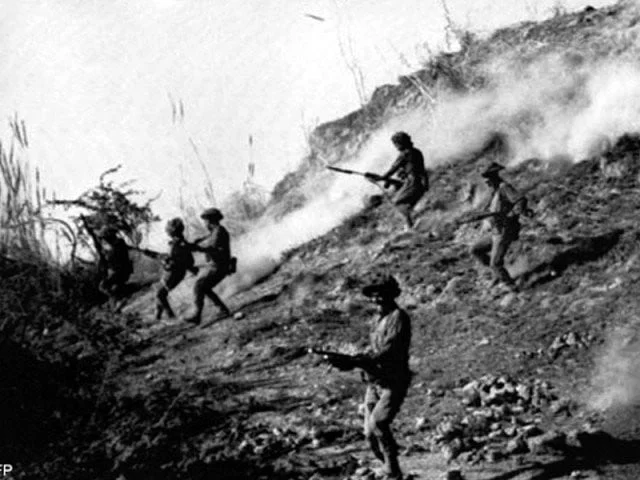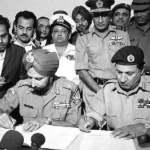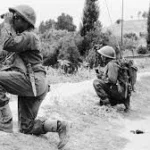Based on the thread initiated by Dr. Hassaan Bokhari (@shbokhari13), we are presenting the subject matter in its more expansive format. Enjoy reading!
Were 3 million Bengalis killed and 2 lakh women raped by the Pakistan Army in East Pakistan during 1971? What happened to the non-Bengalis and non-Biharis in East Pakistan? Were Hindus in East Pakistan targeted for special atrocities? If yes, then by whom? Can the term “genocide” be applied accurately to any party’s actions in East Pakistan in 1971?
Let us begin with the widely cited 3 million deaths and 2 lakh rapes of the “Genocide” in East Pakistan. It is an accepted fact that the three Pakistani army divisions in East Pakistan didn’t consist of more than 34,000 to 45,000 soldiers. Let’s take the higher figure. For 45,000 men to kill 3 million and rape 2 lakh in 8 months (from March to November, when the war with India began), they would have to kill 1250 and rape 833 women daily! Each soldier would have to kill 67 victims and rape five women over an area spanning about 150,000 square kilometers! And they would have to do this as they were holding a 4100-kilometer-long border against Indian forces while simultaneously fighting battles with both the Mukti Bahini and their allied Indian troops, in which they lost 4000 lives with a stunning casualty rate of 10%!
Let’s examine another historical illustration. 6 million Jews were allegedly killed by the Germans in Eastern Europe during the years 1939–45 as a result of deliberate Nazi government policy. The government supplied massive manpower, bureaucratic and logistical resources, and a remorseless will to conduct this murderous enterprise. Now, the 6 million figure has come forth after a great deal of proper research, but it is still questioned by many. I would wager confidently on my prediction that if a poll were to be conducted in Bangladesh asking if the 6 million Jewish victim number for the Holocaust is true, the majority will answer in the negative! But let’s proceed with the higher figure in this discussion. 6 million in 6 years means 2700 killings per day, i.e., 5 times less than the number claimed by Indians and the Awami League for East Pakistan. Now let’s compare the number of perpetrators as well. More than 3 million German soldiers were posted on the Eastern Front in 1941. Many were killed, and many more were recruited over the years. There were also tens of thousands of SS men. But for the sake of simplicity, let’s just proceed with the lower estimate of 3 million Germans operating on the Eastern front. The average number of killings per person is 2 every 6 years! So, the Nazis with their huge resources, ideological commitment, and immense racist antisemitic propaganda managed a rate of one killing per person, or 0.2 kills per 8 months, in contrast to the alleged rate of 67 kills per 8 months for the Pakistan Army (335 times more than the Nazis!) which was serving under a government that deliberately hid the killings of non-Bengalis by Bengalis in East Pakistan for fear of a racist backlash against millions of Bengalis then living peacefully in West Pakistan!
Obviously, the figures of 3 million killed and 2 lakh raped in the “Genocide” in East Pakistan are rumors.
But why was this rumor circulated? Why has the Awami League made it an article of faith? Why does the Indian government propagate this lie incessantly all over the world? Well, for the Awami League, it was (and is) a way to generate political capital. The Indians are smarter and have a deeper reason. Abdul Mumin Chaudhry, an Awami Leaguer and a separatist who participated in the struggle against the Pakistani army himself in 1971, is right on point when he mentions that the Indians wanted to create a permanent hatred between the brotherly Muslim peoples of West Pakistan and Bangladesh/East Pakistan.
India wanted to smear the Islamic name and perpetually destroy the bonds of Islamic unity. Hence, it embarked on a propaganda offensive to portray the Pakistani army as more brutal than Genghis Khan and more genocidal than the Nazis. (pic 31) Afrasiab Qureshi mentions in his book “1971: Fact and Fiction” that this “mission” of hatred creation had begun quite early in the war when Indian BSF troops (wearing Khaki uniforms similar to those of the Pakistani army) committed numerous killings and rapes in the border areas while masquerading as Pakistani soldiers. Abdul Mumin has correctly observed that India wants to dent the Islamic identity of Bangladeshi Muslims by giving them a “splintered self-image” so that they can never develop the confidence and ideological clarity to recognize Indian malevolence and thwart Indian attempts at hegemony over Bangladesh.
Sadly, this nefarious Indian enterprise about the “Genocide” in East Pakistan is fully backed by the Awami League in Bangladesh. Like many Pakistani political parties, Awami League is only interested in power in order to loot wealth through corruption and enjoy the perks of higher status in society. Like many Pakistani political parties, the Awami League is supremely disinterested in what is good or bad for their country and is willing to do anything to capture and retain power.
That is why the Awami League government in Bangladesh has severely penalized anyone who dares speak the truth about this matter. For example, Begum Akhtar Imam (the provost of Rokeya Hall for women students at Dhaka University) was labelled a collaborator and sacked from her job when she refused to support the lies about hundreds of female students being raped and killed by the Pakistan army when, in reality, Rokeya Hall was empty by March 25.
But here I will mention some efforts in Bangladesh itself to calculate the actual number.
One of Bangladesh’s founding fathers, Kamal Hossein’s son-in-law, David Bergman, faced criminal charges brought up by the Awami League government when he wrote an article titled “Questioning an Iconic Number” in the Indian publication The Hindu in 2014.
In this article, Bergman mentioned that Sheikh Mujib himself tried to determine the total number of people killed by the Pakistan Army in the “Genocide” in East Pakistan after publicly declaring the number to be 3 million. But when the actual number was found to be around 50,000, he lost his cool and shut down the efforts for accurate data collection.
Interestingly, Sheikh Mujib, in a speech on January 10, 1972, mentioned that 30 lakh were killed at one point and 3 lakh were killed at another in the “Genocide” in East Pakistan.
Mujib got this spurious number from the Soviet newspaper Pravda, which floated the number without any factual basis in December 1971.
Abdul Muhaiman, a friend of Mujib and a member of Bangladesh’s legislative assembly during Mujib’s reign, himself widely traveled and traced the victims in the Noakhali district and found the number to be less than 7000.
Bangladesh had 19 districts at the time, and if this figure is multiplied by 19, the total is around 130000. But Noakhali was one of the worst-hit districts in East Pakistan, and as Sarmila Bose mentions in her book, most areas suffered considerably less violence in the “Genocide” in East Pakistan.
Like the committee commissioned by Sheikh Muji himself, Sarmila Bose (an Indian Hindu Bengali belonging to the famous Bose family of the Indian National Congress), who should have been anti-Pakistan had she been biased, puts the number of total victims between 50,000 and 1 lakh (including those who fought and died for the Pakistani side).
In the October 1993 issue of the Journal of the Bangladesh International Institute of Strategic Studies, Abdur Rab Khan, a senior researcher at the institute, has shown that eight hundred thousand people sacrificed their lives during the prolonged struggle for the creation of Pakistan. As against this, during the Indo-Pakistan war leading to the creation of Bangladesh, 11,000 soldiers on both sides were killed. During the period of civil war between the Pakistan Army and the Bangladeshi rebels before the war itself, a total of 50,000 lives were lost.
Even the Indians themselves couldn’t lie that much when the memories of the conflict were fresh. Sisson and Rose interviewed Indian officials about the matter, who, while trying to obviously inflate the number in service of their country’s policy, claimed that about 3 to 5 lakh people were killed in total.
In June 1972, William Drummond, a journalist for The Guardian, also called the 3 million figure absurd. And he also did travel widely in Bangladesh when the conflict was just a few months old and the wounds of the victims were fresh.
Quite tellingly, where Bangladesh has penalized, demonized, or canceled any and all of those who have dared to question the myth of 3 million during the “Genocide” in East Pakistan, Pakistan has facilitated foreign researchers like Bose and Yasmin Saikia in their quest for research on the 1971 war. Saikia mentions in her book “Women, War, and the Making of Bangladesh: Remembering 1971,” “I was surprised that despite the delicate nature of my research, no one put obstacles in my way (in Pakistan) and I was allowed to investigate the story and the historical sources without any problems.” But both did face a lot of hatred and obstructive behavior from the Awami League authorities in Bangladesh as soon as it became apparent that they weren’t going to toe the Awami League narrative without a factual basis.
This reluctance to learn the truth is also the basis for the AL authorities’ almost complete denial of any atrocities committed by Bengalis against non-Bengalis in 1971. Saikia mentions her surprise at the dehumanizing of Bihari women by Bengali women (themselves victims of atrocities), with the result that they thought atrocities against Bihari women were “justified.”
On the other hand, to Saikia’s surprise, the Bihari women victims expressed no such behavior and showed compassion towards the Bengali victims of war.
The critique of the gigantic lie about the 3 million figure of the “Genocide” in East Pakistan doesn’t mean that atrocities weren’t committed by the Pakistani army. Indeed, atrocities occurred, such as the Shankaripara massacre (18 people were killed, according to an eyewitness whose own father was among the slain, as opposed to a ludicrous claim of 8000 killed!).
Thanapara massacre (in which dozens were killed in cold blood) and the killings of dozens of unarmed civilians, including teachers, in the Dhaka university after the militants there had been overcome. Interestingly, Brigadier Jahanzeb Arbab and Colonel Basharat were the commanding officers in all three actions. Interestingly, these two gentlemen were also suspected of corruption and looting of public funds, and the Hamood-ur-Rahman Commission report (which put the total number of Pakistan Army killings at 26,000) recommended that both of these officers be tried and punished. Sadly, this never came to pass, although it was the sole responsibility of the government of Pakistan that such criminals be made examples of.
Now, I will discuss the ordeal endured by the non-Bengalis and Biharis in 1971–72. Like Saikia, Sarmila Bose also found a widespread tendency in Bangladesh to deny or justify the atrocities committed against the Biharis.
Anthony Mascharenas’s article about killings by the Pakistani army (published in London during the 1971 civil war) is very famous. Many see it as “proof” of the Pakistani army’s brutality. But it has been ignored by Indians and the Awami League that the same article mentions that by June 1971, more than 100,000 Biharis had been mercilessly killed by the Bengalis.
Mascharenas’s report, as Bose has shown in her well-researched book, is very inaccurate, though, and it appears he grossly inflated the numbers of victims (both Bengalis and Biharis) because he almost exclusively relied on hearsay. Pakistani journalist Qutbuddin Aziz claimed that 5 lakh Biharis were killed during March and April 1971. This figure is also obviously exaggerated.
But it is undeniable that over the period from March 1, 1971, to mid-1972, the Biharis faced a ruthless ethnic cleansing campaign by the Bengalis. Unlike the Pak army, which almost exclusively targeted adult males (often Hindus) because it wanted to quell the rebellion, the Bengali fighters and mobs wiped out whole families regularly.
Masood Mufti mentions in his book “Lamhay” the eyewitness accounts of the horrific massacres at places like Santahar (where a 30000-strong Bihari population was completely and systematically wiped off over a period of several weeks), Chittagong, Khulna, Mymensingh, and Dinajpur. In border towns like the latter two, the Indians were openly involved in the atrocities and even developed a human trafficking business in which they abducted Bihari women in large numbers and sold them across the border in India. These atrocities were not given the attention and coverage they merited because the Pakistani government wanted to avoid a backlash against Bengalis in West Pakistan, which could have resulted had the graphic details of violence against non-Bengalis been published then.
Even Bengalis, who dared to show humanity in such places or were loyal to Pakistan, were brutally killed in large numbers. Former ministers like Molvi Farid and Ajmal Chaudhry were killed after horrific torture conducted in broad daylight in December 1971. Bengali military officers did kill their erstwhile West Pakistani colleagues in large numbers at the end of March 1971. The massacres of whole families of West Pakistani servicemen (especially in Joydevpur and Chittagong by the 2 EB and 8 EB regiments) are well known. Some Bengali officers who tried to protect the families of their West Pakistani colleagues were also gunned down. It was no wonder then that Sheikh Mujib, considered a traitor by the Pakistani army, was neither killed nor tortured, nor was his family harmed, when he was arrested by Pakistani forces in 1971. But when his own Bangladeshi army turned against him, the Bengali veterans of the 1971 civil war brutally killed him and dozens of his family members.
Now I’ll address the issue of Pakistani Army violence against Hindus. There is no doubt about the fact that a vast majority of the Hindu population of East Pakistan has exhibited and maintained more loyalty towards India than Pakistan since 1947. Even in today’s Bangladesh, the Hindus exhibit these tendencies. As a result, it was widely believed inside the Pakistani army that the Hindus were the main instigators of the 1971 rebellion. It is an undeniable fact that the Pakistani army singled out the Hindus for brutal treatment while generally sparing the Muslims. In this anti-Hindu crusade, the local Bengali Muslims also took part.
In many areas, the locals reported the Hindus to the army, which wiped out the adult males. Then the locals would loot the remaining Hindus and push them outside. As a result, more than 80% of the refugees who crossed the border into India turned out to be Hindus, according to Sisson and Rose. The leading example of this phenomenon is the Chuknagar Massacre, where paramilitary forces allied with the Pakistan Army killed hundreds of Hindu men and then left. The survivors were then relieved of their valuables and pushed across the border.
Lastly, I come to the question of genocide. The attached picture shows the UN definition of the term “genocide.”
Even Archer Blood, who had a clear anti-Pakistan bias, declined to use the term “genocide” for Bengali Muslim killings. He did use it for Bengali-Hindu killings, though.
Sarmila Bose presented a more nuanced and unbiased opinion that was rooted in facts. She did not label the Hindu killings as genocide; only those killings that used religious profiling prior to victim selection were labelled as such. She did, however, categorically condemn ethnic cleansing of non-Bengalis as racially motivated genocide.
The final verdict about the sorrowful episode of 1971 given by Yasmin Saikia is completely correct. It was a classic civil war in which the weak and vulnerable faced extreme hardship while the worst people among Bengalis, the Pakistani army, Biharis, and Hindus preyed upon the innocent.
Wherever there was some organization and discipline (in the case of the Pak army and some units of Mukti Bahini), the violence was targeted and controlled. But where discipline and organization were weak or nonexistent (in cases of irregular soldiers and mobs), the violence was more horrific, uncontrolled, and more tilted towards the weak women and children, who proved to be easier targets.
I will end this thread by sharing an excerpt from Saikia’s book: “It is time for the states of Pakistan and Bangladesh, which were involved in creating and facilitating the violence, to execute their national will and take responsibility for their crimes.” I agree. Let’s face the facts and own up to our wrongdoings instead of playing the victim and promoting a narrative full of baseless and hate-generating lies. Abdul Mumin rightly observed that such hate-generating behavior devoid of introspection only serves to benefit India’s ambitions, which ultimately want both Pakistan and Bangladesh destroyed. Only by embracing the truth and rejecting the lies peddled by the enemy can the way to brotherhood be discovered.
War in 1971: The Western Front
Your go-to editorial hub for policy perspectives and informed analysis on pressing regional and global issues.





Add a Comment